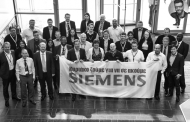If the universe is just a Matrix-like simulation, how could we ever know? Physicist Silas Beane thinks he has the answer
The idea that we live in a simulation is just science fiction, isn’t it?
There is a famous argument that we probably do live in a simulation. The idea is that in future, humans will be able to simulate entire universes quite easily. And given the vastness of time ahead, the number of these simulations is likely to be huge. So if you ask the question: ‘do we live in the one true reality or in one of the many simulations?’, the answer, statistically speaking, is that we’re more likely to be living in a simulation.
There is a famous argument that we probably do live in a simulation. The idea is that in future, humans will be able to simulate entire universes quite easily. And given the vastness of time ahead, the number of these simulations is likely to be huge. So if you ask the question: ‘do we live in the one true reality or in one of the many simulations?’, the answer, statistically speaking, is that we’re more likely to be living in a simulation.
How did you end up working on this issue?
My day job is to do high performance computing simulations of the forces of nature, particularly the strong nuclear force. My colleagues and I use a grid-like lattice to represent a small chunk of space and time. We put all the forces into that little cube and calculate what happens. In effect, we’re simulating a very tiny corner of the universe.
My day job is to do high performance computing simulations of the forces of nature, particularly the strong nuclear force. My colleagues and I use a grid-like lattice to represent a small chunk of space and time. We put all the forces into that little cube and calculate what happens. In effect, we’re simulating a very tiny corner of the universe.
How accurate are your simulations?
We’re able to calculate some of the properties of real things like the simplest nuclei. But the process also generates artefacts that don’t appear in the real world and that we have to remove. So we started to think about what sort of artefacts might appear if we lived in a simulation.
We’re able to calculate some of the properties of real things like the simplest nuclei. But the process also generates artefacts that don’t appear in the real world and that we have to remove. So we started to think about what sort of artefacts might appear if we lived in a simulation.
What did you discover?
In our universe the laws of physics are the same in every direction. But in a grid, this changes since you no longer have a spacetime continuum, and the laws of physics would depend on direction. Simulators would be able to hide this effect but they wouldn’t be able to get rid of it completely.
In our universe the laws of physics are the same in every direction. But in a grid, this changes since you no longer have a spacetime continuum, and the laws of physics would depend on direction. Simulators would be able to hide this effect but they wouldn’t be able to get rid of it completely.
How might we gather evidence that we’re in a simulation?
Using very high energy particles. The highest energy particles that we know of are cosmic rays and there is a well-known natural cut off in their energy at about 1020 electron volts. We calculated that if the simulators used a grid size of about 10-27 metres, then the cut off energy would vary in different directions.
Using very high energy particles. The highest energy particles that we know of are cosmic rays and there is a well-known natural cut off in their energy at about 1020 electron volts. We calculated that if the simulators used a grid size of about 10-27 metres, then the cut off energy would vary in different directions.
Do cosmic rays vary in this way?
We don’t know. The highest energy cosmic rays are very rare. A square kilometre on Earth is hit by one only about once per century so we’re not going to be able map out their distribution any time soon. And even if we do, it’ll be hard to show that this is conclusive proof that we’re in a simulation.
We don’t know. The highest energy cosmic rays are very rare. A square kilometre on Earth is hit by one only about once per century so we’re not going to be able map out their distribution any time soon. And even if we do, it’ll be hard to show that this is conclusive proof that we’re in a simulation.
But can we improve our own simulations?
The size of the universe we simulate is a just fermi, that’s a box with sides 10-15 metres long. But we can use Moore’s Law to imagine what we might be able to simulate in future. If the current trends in computing continue, we should be simulating a universe the size of a human within a century and within five centuries, we could manage a box 1026 metres big. That’s the size of the observable universe.
The size of the universe we simulate is a just fermi, that’s a box with sides 10-15 metres long. But we can use Moore’s Law to imagine what we might be able to simulate in future. If the current trends in computing continue, we should be simulating a universe the size of a human within a century and within five centuries, we could manage a box 1026 metres big. That’s the size of the observable universe.
How have people reacted to your work?
I gave a lecture on this topic the other week and the turnout was amazing. Half of the people looked at me as if I was disturbed and the other half were very enthusiastic
I gave a lecture on this topic the other week and the turnout was amazing. Half of the people looked at me as if I was disturbed and the other half were very enthusiastic
editing: jkoulouris
















